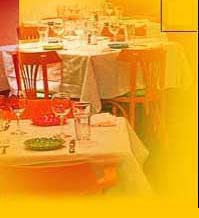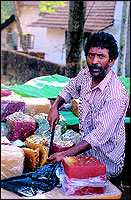


|
|
|
EVERY city has at least one sweet named after it and for which it is gastronomically renowned. In Calicut, it is the thick, black, glutinous Calicut Halwa. Every sweet shop, every bakery, every major store selling food items and packaged foods, sells the ubiquitous Calicut Halwa. You will find the halwa stacked behind a glass counter, a big, fat, black mass, glistening with oil, and with a sickly sweet smell about it. Visitors to the city are initiated into developing a Calicut Halwa fix by crafty salespersons in these stores who cut a thin slice of the sweetmeat and offer it for sampling. Once tasted, the visitor gets hooked onto the halwa.
Depending on the quality of coconut oil used, this halwa can be stored for upto three months if it is not exposed to moisture. If the coconut oil is of an inferior quality, the halwa tends to get rancid early. But there are little chances of that happening in most Keralite households in Calicut. The people buy their halwa fresh and in small quantities. And they consume it quickly. The black halwa is most popular. It costs Rs. 36 a kilo. The other coloured halwas do not taste much different, even though the orange, white and yellow varieties are jazzed up with chopped nuts, elaichi, and jeera. Flavours are not added, only colours. There is a banana halwa, too, which is made in vanaspati and not oil. Locals will not advise buying it. �Black is best,� they will say.
|

Home Page
About the mag
Subscribe
Advertise
Contact Us

 Calicut Halwa Very Oily! Very Tasty!
Calicut Halwa Very Oily! Very Tasty!
 Besides which, even if he or she did not intend buying some of the halwa, chances are Keralite friends back home would have asked them to carry a small parcel of the Calicut delicacy back.
In Calicut, along the highway leading onto the airport and other neighbouring cities, several small stalls are set up during the Sabarimala pilgrimage season for the faithful to pick up their supply of the famous halwa. The business these stalls do is amazing, even though they are located close to one and other, and all sell the same sweet. The pilgrims spill out of cars, buses and autorickshaws dressed in black lungis and shirts, looking unkempt from the rigors of their pilgrimage, and flock to the halwa stalls in great excitement. Although most of them have probably been doing this for years, it is a great ritual for them to sample the black halwa, and then its variants in orange, yellow, green, red and pink.
Besides which, even if he or she did not intend buying some of the halwa, chances are Keralite friends back home would have asked them to carry a small parcel of the Calicut delicacy back.
In Calicut, along the highway leading onto the airport and other neighbouring cities, several small stalls are set up during the Sabarimala pilgrimage season for the faithful to pick up their supply of the famous halwa. The business these stalls do is amazing, even though they are located close to one and other, and all sell the same sweet. The pilgrims spill out of cars, buses and autorickshaws dressed in black lungis and shirts, looking unkempt from the rigors of their pilgrimage, and flock to the halwa stalls in great excitement. Although most of them have probably been doing this for years, it is a great ritual for them to sample the black halwa, and then its variants in orange, yellow, green, red and pink. The halwa sellers, veterans of the business, recognise a good sale when they see one. They don�t mind the pilgrims sampling the halwa, even though everybody knows it all tastes the same.
The black Calicut Halwa is made very simply out of maida and sugar, palm jaggery, and it is cooked in coconut oil. Cooked would be putting it mildly because the halwa is soaking in oil. You buy a small portion and take it home and the halwa sweats the oil out every day.
The halwa sellers, veterans of the business, recognise a good sale when they see one. They don�t mind the pilgrims sampling the halwa, even though everybody knows it all tastes the same.
The black Calicut Halwa is made very simply out of maida and sugar, palm jaggery, and it is cooked in coconut oil. Cooked would be putting it mildly because the halwa is soaking in oil. You buy a small portion and take it home and the halwa sweats the oil out every day.